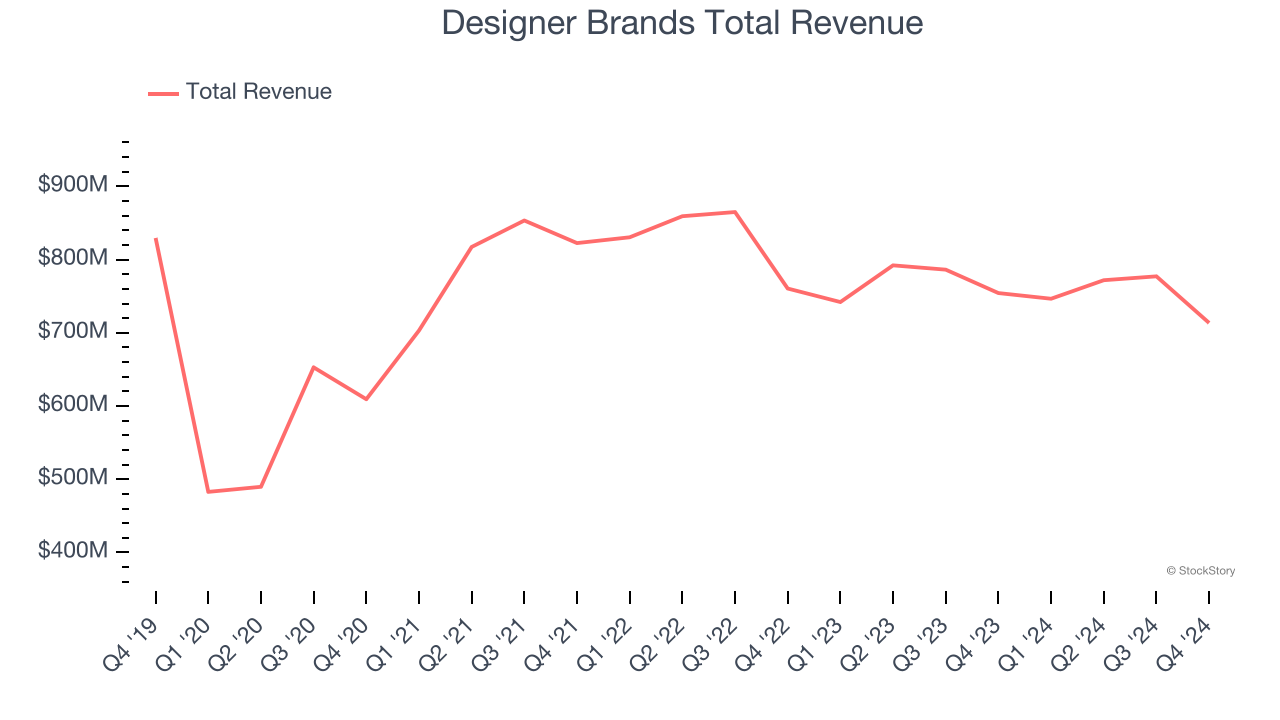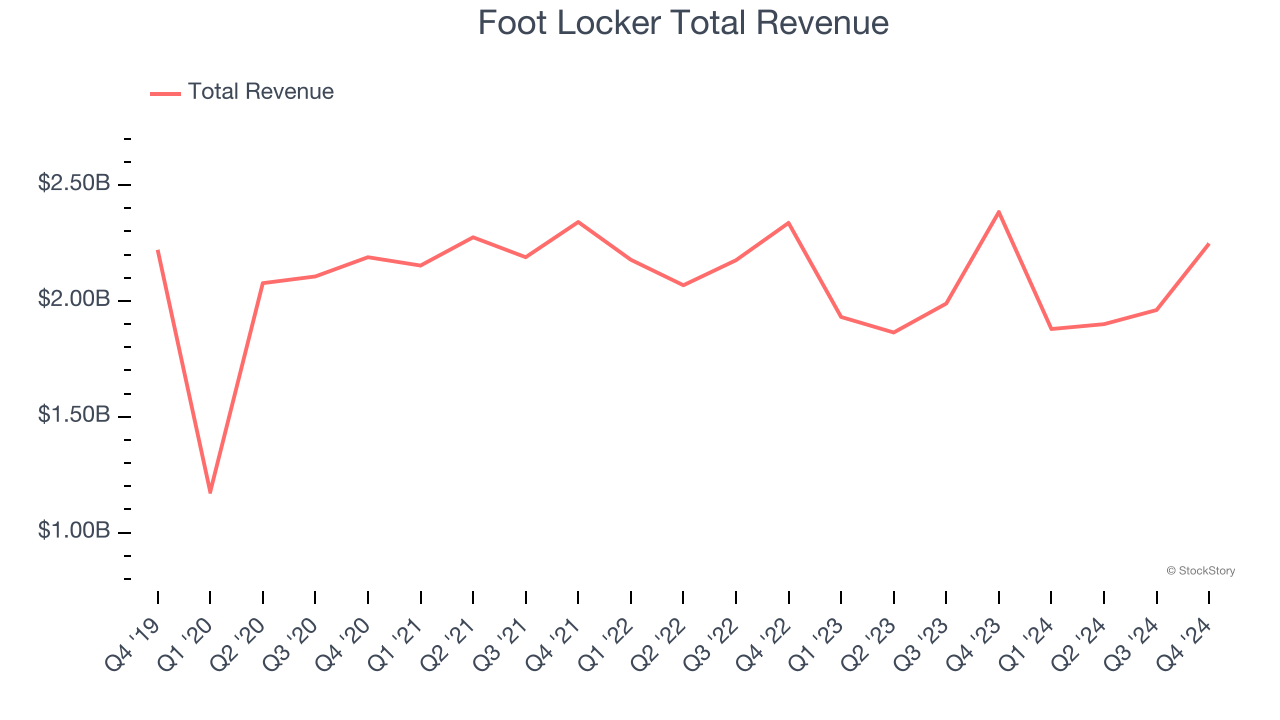
The end of an earnings season can be a great time to discover new stocks and assess how companies are handling the current business environment. Let’s take a look at how Designer Brands (NYSE:DBI) and the rest of the footwear retailer stocks fared in Q4.
Footwear sales–like their apparel counterparts–are driven by seasons, trends, and innovation more so than absolute need and similarly face the bigger-picture secular trend of e-commerce penetration. Footwear plays a part in societal belonging, personal expression, and occasion, and retailers selling shoes recognize this. Therefore, they aim to balance selection, competitive prices, and the latest trends to attract consumers. Unlike their apparel counterparts, footwear retailers most sell popular third-party brands (as opposed to their own exclusive brands), which could mean less exclusivity of product but more nimbleness to pivot to what’s hot.
The 4 footwear retailer stocks we track reported a slower Q4. As a group, revenues missed analysts’ consensus estimates by 1.7% while next quarter’s revenue guidance was 0.6% below.
Amidst this news, share prices of the companies have had a rough stretch. On average, they are down 29.5% since the latest earnings results.
Designer Brands (NYSE:DBI)
Founded in 1969 as a shoe importer and distributor, Designer Brands (NYSE:DBI) is an American discount retailer focused on footwear and accessories.
Designer Brands reported revenues of $713.6 million, down 5.4% year on year. This print fell short of analysts’ expectations by 0.8%. Overall, it was a disappointing quarter for the company with full-year EPS guidance missing analysts’ expectations.
"Positive comparable sales in the fourth quarter reflect a return to growth for the first time in nine quarters, highlighting the success of our strategic initiatives throughout the year," stated Doug Howe, Chief Executive Officer.

The stock is down 26.7% since reporting and currently trades at $2.78.
Read our full report on Designer Brands here, it’s free.
Best Q4: Foot Locker (NYSE:FL)
Known for store associates whose uniforms resemble those of referees, Foot Locker (NYSE:FL) is a specialty retailer that sells athletic footwear, clothing, and accessories.
Foot Locker reported revenues of $2.25 billion, down 5.7% year on year, falling short of analysts’ expectations by 3.2%. The business performed better than its peers, but it was unfortunately a mixed quarter with an impressive beat of analysts’ EBITDA estimates but full-year EPS guidance missing analysts’ expectations.

The stock is down 29% since reporting. It currently trades at $12.34.
Is now the time to buy Foot Locker? Access our full analysis of the earnings results here, it’s free.
Shoe Carnival (NASDAQ:SCVL)
Known for its playful atmosphere that features carnival elements, Shoe Carnival (NASDAQ:SCVL) is a retailer that sells footwear from mainstream brands for the entire family.
Shoe Carnival reported revenues of $262.9 million, down 6.1% year on year, falling short of analysts’ expectations by 2.7%. It was a softer quarter as it posted full-year EPS guidance missing analysts’ expectations.
Shoe Carnival delivered the slowest revenue growth and weakest full-year guidance update in the group. As expected, the stock is down 21.9% since the results and currently trades at $17.69.
Read our full analysis of Shoe Carnival’s results here.
Boot Barn (NYSE:BOOT)
With a strong store presence in Texas, California, Florida, and Oklahoma, Boot Barn (NYSE:BOOT) is a western-inspired apparel and footwear retailer.
Boot Barn reported revenues of $608.2 million, up 16.9% year on year. This print was in line with analysts’ expectations. More broadly, it was a mixed quarter as it also logged a decent beat of analysts’ EBITDA estimates but EPS guidance for next quarter missing analysts’ expectations.
Boot Barn achieved the biggest analyst estimates beat, fastest revenue growth, and highest full-year guidance raise among its peers. The stock is down 40.4% since reporting and currently trades at $104.12.
Read our full, actionable report on Boot Barn here, it’s free.
Market Update
As a result of the Fed’s rate hikes in 2022 and 2023, inflation has come down from frothy levels post-pandemic. The general rise in the price of goods and services is trending towards the Fed’s 2% goal as of late, which is good news. The higher rates that fought inflation also didn't slow economic activity enough to catalyze a recession. So far, soft landing. This, combined with recent rate cuts (half a percent in September 2024 and a quarter percent in November 2024) have led to strong stock market performance in 2024. The icing on the cake for 2024 returns was Donald Trump’s victory in the U.S. Presidential Election in early November, sending major indices to all-time highs in the week following the election. Still, debates around the health of the economy and the impact of potential tariffs and corporate tax cuts remain, leaving much uncertainty around 2025.
Want to invest in winners with rock-solid fundamentals? Check out our Top 6 Stocks and add them to your watchlist. These companies are poised for growth regardless of the political or macroeconomic climate.
Join Paid Stock Investor Research
Help us make StockStory more helpful to investors like yourself. Join our paid user research session and receive a $50 Amazon gift card for your opinions. Sign up here.
